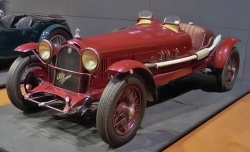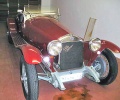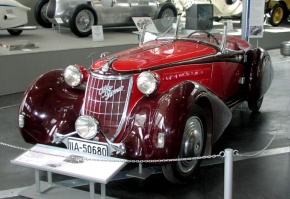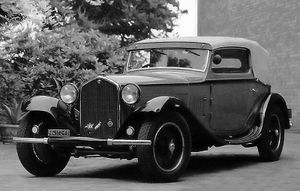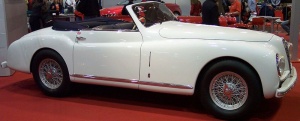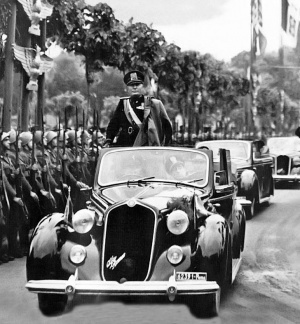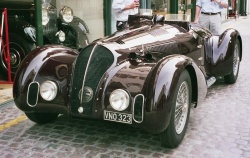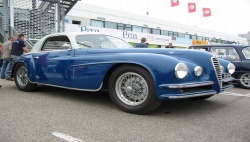Alfa Romeo 6C
| 250px | |
| Alfa Romeo 6C | |
|---|---|
| Manufacturer | Alfa Romeo |
| Parent Company | Fiat |
| Production | 1925; 1954 |
| Assembly | |
| Predecessor | Alfa Romeo RM |
| Successor | Alfa Romeo 1900 |
| Class | |
| Body Style | |
| Layout | |
| Platform | FR/RWD |
| Engine | 1.5 L I6 1.7 L I6 1.9 L I6 2.3 LI6 2.5 L I6 3.0 L I6 3.5 L I6 |
| Transmission | |
| Wheelbase | |
| Length | |
| Width | |
| Height | |
| Ground Clearance | |
| Front Track | |
| Rear Track | |
| Weight | |
| Top Speed | |
| Fuel Capacity | |
| Related | |
| Similar | |
| Designer | |
The Alfa Romeo 6C name was used on road, race and sports cars made between 1925–1954 by Alfa Romeo. 6C refers to to a straight 6 engine. Bodies to these cars were made by coachbuilders like: James Young, Zagato ,Touring ,Castagna and Pininfarina. Starting from 1933 there was also 6C version with Alfa Romeo own body manufactured in Portello.
85 hp, 1,752 cc twin-overhead camshaft inline six-cylinder engine with supercharger, four-speed manual gearbox, tubular front beam axle and semi-elliptic leaf springs, semi-elliptic rear springs and torque tube, four-wheel drum brakes. Wheelbase: 108"
Alfa Romeo began in 1906 under the name of SAID, Societa Anonima Italiana Darracq, but within just three years was reorganized under a different set of initials, ALFA – Anonima Lombarda Fabbrica Automobil. In an effort to boost its image, the company decided to go racing, beginning in 1911 with some success. Shortly thereafter, Europe would find itself at war. Both racing and the market for private cars would disappear by 1915 when Italy joined the fighting.
Enter Nicola Romeo, an industrialist and mining engineer who returned the company to good fortune within just two years of his takeover by making tractors, railway equipment, aero engines, pumps and compressors; the production of cars would become relatively unimportant. That would change in 1918 when demand for the Romeo group’s products vanished once the War ended. Cars would be in short supply, and demand for them surged. The company looked to reorganise under the name Alfa Romeo of Milan, and one of the most famous makes in European motoring was born.
Alfa was building good, reliable production cars but lacked the expertise to design successful racing cars, so a scheme was hatched to hire the engineer responsible for Fiat’s grand prix racing cars, Vittorio Jano. The hiring of Jano proved a wise decision as he brought with him unrivaled flair, experience and the latest in race car design. Enzo Ferrari, too, had joined the company as a works driver. The Italian maker would return to its roots in racing with much success, winning its first Grand Prix World Championship in 1925.
Alfa Romeo introduced the 1752 cc six-cylinder powered cars designed by Jano in 1929. Adept on both road and racing circuits, the power plant proved reliable and powerful, offering impressive output from its relatively small displacement. Further benefiting from excellent handling, the car, in top factory racing engine trim, could comfortably exceed 161 km/h.
The 6C 1750 is significant for introducing in-house manufactured saloon bodies along with those produced by firms such as Touring, Castagna and Zagato, among others. Three models were available: the single overhead-cam Turismo with 122-inch wheelbase and a maximum speed of about 70 mph, the twin overhead-cam Gran Turismo with 108-inch or 114-inch wheelbase and a top speed of about 80 mph, and the Gran Sport or Super Sport – a supercharged Gran Turismo producing 85 hp and a top speed of 95 mph. Regardless of the version, the 6C remains today one of the most compelling and desirable of all Alfas. All told, the Alfa Romeo built a total of 2,579 1750s through 1933.
Just three months after its introduction, a 1750 driven by Giuseppe Campari and Giulio Ramponi would win the 1929 Mille Miglia. Later that year, Marinoni and Benoist won the Belgian 24 Hour Race at Spa. Alfa would take the Targa Florio, too, and one year later, the company won its second Mille Miglia in addition to a host of other events. The company went on to take the chequered flag in eight Mille Miglias during the 1930s as well as the German Grand Prix in 1935 against the formidable Mercedes-Benz and Auto Union entries. Alfa Romeo began the 1930s as it ended the 1920s, dominating Italy’s sports car and competition scene.
6C 1500 (1925-1929)
Mid 1920s Alfa Romeo RL was considered too large and heavy, so new car development started. 6C 1500 was introduced in 1925 Milan and production started 1927. Alfa Romeo P2 Grand Prix car was taken as starting point. Engine capacity was now 1487 cc instead of P2's 1987 cc, also supercharger was dropped away. First versions were carrying bodies from James Young and Carrozzeria Touring.
In 1928 6C Sport version was released, this car had engine with two overhead camshafts. Sport version won many races like the 1928 Mille Miglia. Total production amount was 3000, (200 with DOHC engine). Supercharged Super Sport variant was made 10 pieces.
Variants:
- 6C 1500, 44 bhp @ 4400 rpm, 109 km/h (1925-1929)
- 6C 1500 Sport, 54 bhp @ 4500 rpm, 125 km/h (1928-1929)
- 6C 1500 Super Sport compressore, 76 bhp @ 4800 rpm, 140 km/h (1928-1929)
- 6C 1500 TF, 84 bhp @ 5000 rpm (1928-1929)
6C 1750 (1929-1933)
| 1930 Alfa Romeo 6C 1750 |
|---|
More powerful 6C 1750 was introduced in 1929 in Rome. Engine was enlarged now to 1752 cc. Base model was with one overhead camshaft and Super Sport and Gran Sport versions had DOHC engine. Total production was 369.
Variants:
- 6C 1750 Turismo, 46 bhp @ 4000 rpm, 109 km/h (1929-1933)
- 6C 1750 Sport/Gran Turismo, 55 bhp @ 4400 rpm, 125 km/h (1929-1932)
- 6C 1750 Super Sport/Gran Sport, 64 bhp @ 4500 rpm, 130 km/h (1929-1932)
- 6C 1750 Super Sport/Gran Sport compressore,85 bhp @ 4500 rpm, 144 km/h) (1929-1932)
- 6C 1750 Gran Turismo compressore, 80 bhp @ 4400 rpm, 135 km/h (1931-1932)
- 6C 1750 Super Sport/Gran Sport/TF, 85 bhp @ 4800 rpm, 170 km/h (1929-1930)
6C 1900 (1933)
6C 1900 (1917 cc, 68 bhp) was introduced 1933, the engine now for the first time, had an aluminium head. Only 197 were made.
Variants:
- 6C 1900 GT, 68 bhp @ 4500 rpm, 130 km/h
6C 2300 (1934-1937)
6C 2300 was designed by Vittorio Jano as a cheaper alternative to the 8C. Engine capacity was increased to 2309 cc.
The next evolution of the 6C came in 1934, and although traditional in its layout, the 6C 2300 had nearly twice the displacement of the car it succeeded. Accordingly, it was a highly competent automobile capable of providing excellent performance with multi-passenger coachwork.
The 2,309cc engine in the 6C 2300 featured a one-piece crankcase/cylinder block and aluminum alloy cylinder head. Camshaft drive was by a combination of roller chain and gears. Designed for performance without the complication and expense of superchargers, the 6C 2300 delivered 68 horsepower in Turismo form. The 6C 2300B, introduced in 1938, offered up to 95 horsepower in the short wheelbase chassis.
The chassis itself was built around boxed section frame rails and, unusual for its market niche, featured fully independent suspension. Its brakes (large drums with aluminum cooling fins shrunk around the cast iron drums) were very effective for the time and, like the engine, showed Alfa's continuing emphasis on performance.
The sporting character of the new 6C was demonstrated by competition success, first in the Mille Miglia in 1937 where Giovanbattista Guidotti (who had apparently learned well from previous Mille Miglia co-drives with Nuvolari) and Mussolini’s chauffeur Ercole Boratto finished fourth overall behind the Two-Nines of Pintacuda and Farina and the Delahaye of Schell. Guidotti’s drive in the 6C 2300 earned Alfa the important "National Touring" class laurels.
The 6C 2300B chassis is known for its nimble and precise handling and is even more responsive in the short wheelbase. Its fully-independent suspension is at the same time compliant and comfortable making it the ideal vehicle for tours and events. Enjoyment and satisfaction is assured by this example’s high performance 110 horsepower and the long stroke six’s smoothness and torque.
Variants:
- 6C 2300 Turismo, 68 bhp @ 4400 rpm, 120 km/h (1934)
- 6C 2300 Gran Turismo, 76 bhp @ 4400 rpm, 130 km/h (1934)
- 6C 2300B Gran Turismo, 76 bhp @ 4400 rpm (1935-1937)
- 6C 2300 Pescara, 95 bhp @ 4500 rpm, 144 km/h (1934)
- 6C 2300B Pescara, 95 bhp @ 4500 rpm (1935-1937)
- 6C 2300 B Corto/Lungo (1935)
- 6C 2300 B Mille Miglia
6C 2500 (1938-1952)
| 1939 Alfa Romeo 6C 2500SS Corsa Barchetta |
|---|
2500 (2443 cc) was last road car version of 6C series, introduced in 1938. World War II was coming and car development was stopped, but a few hundred 6C 2500's were built from 1940-1945. After war first Alfa Romeo model was 1946 6C 2500 Freccia d'Oro (Golden Arrow). Freccia d'Oro was produced 680 copies between 1946-1951, car had Alfa Romeo's own bodywork and design. Car was sold to wealthy customers like King Farouk, Alì Khan, Rita Hayworth, Tyrone Power and Prince Rainier, car was also featured in The Godfather movie in 1972.
6C 2500 Villa d'Este was introduced in 1949 and was produced until 1952. Car name was derived from "Concours d'Elegance" competition held in Villa d'Este named place, where that Touring Superleggera bodied version won the prize. Villa d'Este was last model from Alfa Romeo which was hand built, only 36 examples was made. 6C was produced until 1952 and was replaced with Alfa Romeo 1900.
| Alfa Romeo 6C 2500 Sport |
|---|
Variants:
- 6C 2500, 90 bhp @ 4600 (1938-1949)
- 6C 2500 Turismo
- 6C 2500 Sport, 95 bhp @ 4600 rpm (1947-1949)
- 6C 2500 Super Sport
- 6C 2500 Super Sport Corsa (1939-1953)
- 6C 2500 Freccia d'Oro 90 bhp @ 4600 rpm (1946-1951)
- 6C 2500 Villa d'Este 110 bhp @ 4800 rpm (1949-1952)
- 6C 2500 GT (1950)
- 6C 2500 Competizione 145 bhp @ 5500 rpm (1948)
6C 3000 (1950-1954)
6C 3000 was prototype made in 1950, basically it was 2500 model with 3L engine. It wasn't until 1952 as CM version was produced to racing purpose, this car had 3.5L engine and was made in four different coupe versions and two spider versions.
Variants:
- 6C 3000 (1948)
- 6C 3000 50 (1950)
- 6C 3000 CM (Competizione Maggiorata, 275 bhp, 250 km/h, 1952)
- 6C 3000 PR (1954)
External links
| Alfa Romeo Automobiles S.p.A., a subsidiary of the Fiat S.p.A. since 1986, car timeline, 1910-1949 | Next -> | |||||||||||||||||||||||||||||||||||||||
| Type | 1910s | 1920s | 1930s | 1940s | ||||||||||||||||||||||||||||||||||||
| 0 | 1 | 2 | 3 | 4 | 5 | 6 | 7 | 8 | 9 | 0 | 1 | 2 | 3 | 4 | 5 | 6 | 7 | 8 | 9 | 0 | 1 | 2 | 3 | 4 | 5 | 6 | 7 | 8 | 9 | 0 | 1 | 2 | 3 | 4 | 5 | 6 | 7 | 8 | 9 | |
| 4-cyl. | 12 HP / 15 HP / 24 HP / 15-20 HP / 20-30 HP | 20/30 HP | RM | |||||||||||||||||||||||||||||||||||||
| 4-cyl. | 40/60 HP | |||||||||||||||||||||||||||||||||||||||
| 4-cyl. | ES Sport | |||||||||||||||||||||||||||||||||||||||
| 6-cyl. | G1 / G2 | RL | ||||||||||||||||||||||||||||||||||||||
| 6-cyl. | 6C - 1500 / 1750 / 1900 / 2300 / 2500 | |||||||||||||||||||||||||||||||||||||||
| 8-cyl. | 8C - 2300 / 2600 / 2900 | |||||||||||||||||||||||||||||||||||||||
| Racing car |
GP | P1 / P2 | Tipo A | Tipo B (P3) | Tipo C (8C-35) | Tipo 308 | 158 / 159 Alfetta | |||||||||||||||||||||||||||||||||
| Bi-motore | 12C | Tipo 512 | ||||||||||||||||||||||||||||||||||||||
